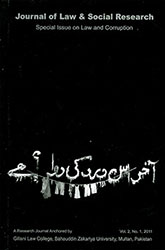Afghanistan: Corruption and Injustice in the Judicial System
DOI:
https://doi.org/10.7146/nnjlsr.v0i2.111121Abstract
No abstract
References
Alhassan-Alolo, N., (2007), “Gender and Corruption: Testing the New Consensus”, Public Administration and Development, Vol. 27: 227-237.
Ahmed, F., (2007), “Afghanistan’s Reconstruction, Five years Later: Narratives of Progress, Marginalized Realities, and the Politics of Law in a Transitional Islamic
Repubblic”, Gonzaga Journal of International Law, 10: 269-309.
Anders, G., Nuijten, M., (2008), “Corruption and the Secret Law: An Introduction”, in M. Nuijten, G. Anders, eds. by, Corruption and the Secret of Law. A Legal
Anthropological Perspective, Ashgate.
ARGO, (2008), “Afghanistan: La necessità di un cambiamento di strategia”, Osservatorio sull’Asia minore, centrale e meridionale, March 2008, Report 4.
Barfield, T., (2012), “Preface”, in A. De Lauri, Afghanistan. Ricostruzione, ingiustizia, diritti umani, Mondadori, Milano (forthcoming).
Bohannan, P. 1965, “The Differing Realms of the Law”, American Anthropologist, Vol. 67, 2: 33-42.
Coppier, R., 2005, Corruzione e crescita economica. Teorie ed evidenze di una relazione complessa, Carocci, Rome. de Sousa, Luis, 2010, “Anti-corruption Agencies: Between Empowerment and Irrelevance”, Journal of Crime, Law and Social Change, Vol 53: 5-22.
Derrida, J., (1994), Force de loi, Galilée, Paris.
Ehrenreich Brooks, R., 2003, “The New Imperialism: Violence, Norms, and the “Rule of Law””, Michigan Law Review, Vol. 101, 7: 2275-2340.
Escobar, A., 2004, “Beyond the Third World: Imperial Globality, Global Coloniality, and Anti-Globalization Social Movements”, Third World Quarterly, Vol. 25, 1: 207-230.
Gardizi, M., Hussmann, K., Torabi, Y., 2010, “Corrupting the State or State-Crafted Corruption?”, Afghanistan Research Evaluation Unit, Kabul.
Giustozzi, A., 2004, “'Good' State vs. 'Bad' Warlords? A Critique of State-Building Strategies in Afghanistan”, LSE, Crisis State Research Center, London.
Grande, E., Mattei, U., 2008, “Giustizia allo specchio”, Antropologia, n. 11, Meltemi, Roma: 25-39.
Gupta, A., 1995, “Blurred Boundaries: the Discourse of Corruption, the Culture of Politics, and the Imagined State”, American Ethnologist, Vol. 22, 2: 375-402.
Gupta, A., 2005, “Narratives of Corruption. Anthropological and Fictional Accounts of the Indian State”, Ethnography, Vol. 6, 1: 5-34.
Hanifi, M. J., 2004, “Editing the Past: Colonial Production of Hegemony Through the Loya Jerga in Afghanistan”, Iranian Studies, Vol. 37, 2: 295-322.
Hanifi, M. J., 2009, “Jerga”, Encyclopedia Iranica.
Hasty, J., 2005, “The Pleasure of Corruption: Desire and Discipline in Ghanian Political Culture”, Cultural Anthropology, Vol. 20, 2: 271-301.
Kahn, P. W., 1999, The Cultural Study of Law, The University of Chicago Press, Chicago.
Mattei, U., Nader, L., 2008, Plunder. When the Rule of Law is Illegal, Blackwell.
Passas, N., 2010, “Anti-corruption Agencies and the Need for Strategic Approaches”, Journal of Crime, Law and Social Change, Vol. 53: 1-3.
Schmidhauser, J. R., 1992, “Legal Imperialism: Its Enduring Impact on Colonial and Postcolonial Judicial System”, International Political Science Review, Vol. 13,
3, pp. 321-334.
Shahrani, N. M., 2002, “War, Factionalism, and the State in Afghanistan”, American Anthropologist, Vol. 104, 3: 715-722.
Turner, S., 2008, “Corruption Narratives and the Power of Concealment: The Case of Burundi's Civil War”, in M. Nuijten, G. Anders, eds. By: Corruption and the
Secret of Law. A Legal Anthropological Perspective, Ashgate.
UNPAN, 2002, “Combating Corruption for Development: The Rule of Law, Transparency and accountability”, http://unpan1.un.org/intradoc/groups/public/
documents/un/unpan005786.pdf
Wiler, L. S., Katzman, K., 2010, “Afghanistan: U.S. Rule of Law and Justice Sector Assistance”, Congressional Research Service, Report.
Downloads
Published
How to Cite
Issue
Section
License
Counting from number 12 (2022), articles published in NNJLSR are licensed under Attribution 4.0 International (CC BY 4.0). Readers are allowed to copy and redistribute the articles in any medium or format, to adapt and revise the articles, and use the articles for commercial purposes, provided that the readers give appropriate credits.
No Creative Commons licenses are applied on articles in number 1 (2009)-11 (2021). All rights reserved by the authors. Readers are allowed to download, read, and link to the articles published in volume 1 (2009)-11 (2021), but they may not republish or redistribute these articles without permission of the authors.

